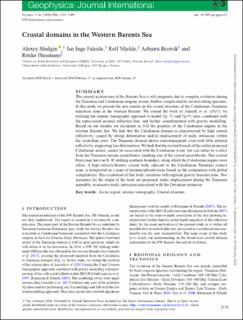| dc.description.abstract | The crustal architecture of the Barents Sea is still enigmatic due to complex evolution during the Timanian and Caledonian orogeny events, further complicated by several rifting episodes. In this study we present the new results on the crustal structure of the Caledonian–Timanian transition zone in the western Barents. We extend the work of Aarseth et al. (2017), by utilizing the seismic tomography approach to model Vp, Vs and Vp/Vs ratio, combined with the reprocessed seismic reflection line, and further complemented with gravity modelling. Based on our models we document in 3-D the position of the Caledonian nappes in the western Barents Sea. We find that the Caledonian domain is characterized by high crustal reflectivity, caused by strong deformation and/or emplacement of mafic intrusions within the crystalline crust. The Timanian domain shows semi-transparent crust with little internal reflectivity, suggesting less deformation. We find, that the eastern branch of the earlier proposed Caledonian suture, cannot be associated with the Caledonian event, but can rather be a relict from the Timanian terrane assemblance, marking one of the crustal microblocks. This crustal block may have an E–W striking southern boundary, along which the Caledonian nappes were offset. A high-velocity/density crustal body, adjacent to the Caledonian–Timanian contact zone, is interpreted as a zone of metamorphosed rocks based on the comparison with global compilations. The orientation of this body correlates with regional gravity maxima zone. Two scenarios for the origin of the body are proposed: mafic emplacement during the Timanian assembly, or massive mafic intrusions associated with the Devonian extension. | en_US |

